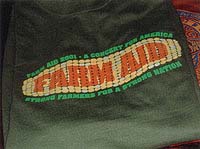
 Rick Roth is president of Rhode Island-based Mirror Image. Between 1995 and 1997, his business took home twenty Golden Image awards in various catagories, as well as top honors in the industry media's various printing competitions.  Mirror Image's commitment to Farm Aid and other charitable organizations gives its artists a chance to spread their creative wings, just as it gives the company a printed piece to use when pitching a "paying customer". Your artist gets a juicy project to sink her teeth into, your company ends up with a showpiece sample, the charity gets a great job, and you just might garner a bit of recognition.  Another example of the author's support of Farm Aid, this unique design represented practice for less-experienced printes and, for the company, a chance to explore a new process. The high-density corn kernels were technically challenging, the result being mastery of a new technique and, for the charity, a novel and profitable design. Rules of Charitable gifting (from page 95) 1. The charity must be a Section 501(c)(3) organization; 2. The charity must use the donated property solely for the care of the ill, the needy or infants; 3. The charity cannot exchange the property for money, other property or services; 4. The benefactor must be given a written statement from the charity that says it will follow rules (2) and (3) above; 5. If the donated property is subject to the regulations of the Federal Food, Drug and Cosmetic Act, then all such regulations must be satisfied; and 6. Use of the property must be related to the purpose or function that gives the charity its exempt status. The amount of the charitable contribution is equal to the retail value of the inventory, less half the difference between the benefactor company's basis in the property and said retail value. However, the charitable contribution cannot exceed twice the benefactor company's basis. |
Give...until it helps! Phun with Philanthropy I truly believe most people are motivated to "do good" and, given the chance, will actively work to make the world a better place. However-forgetting about altruism for a moment-are there other reasons why charitable efforts may actually be good for your company? The fallacies of benevolence My informal polling indicates that many business people believe so, for a couple of reasons. First, they tell me it's good public relations; that, if you do good deeds and get recognized for them, all that "free" publicity will be an advantage to your business and bring you lots of work. Okay, there's a certain logic there, but I don't buy it. It's not even clear that paid advertising works very well to generate business in our industry, never mind whatever uncontrollable promotional value may result from charitable activities. I'm doubtful that even a regular mention in the local news is going to get that sports team, liquor company or bank to call with an order for T-shirts. In fact, not only may such PR fail to bring in business, it's possible that pandering to the media through charitable activities can be seen as a negative if you are perceived-right or wrong-to be using altruism to mask selfish ends. And even if your motives are pure, actually getting that recognition is far from a sure thing. At my company, we've always worked with charities, but only rarely have we been recognized for it. Fourteen years waiting for free publicity can be rather disappointing. . . if that's what you're in it for. I've always found a better return when I invest my resources toward simply calling customers rather than trying to get them to call me. The other common misconception about a business's charitable activities concerns the so-called "tax benefits" that may accrue. Sure, there may be certain advantages, but they're generally modest. In fact, I don't know a single business owner who has actually reaped significant savings on taxes as a result of charitable giving. (See: "Rules of Charitable Gift Giving." page 95.) Thus, it appears that neither publicity nor a tax advantage are legitimate reasons to do good deeds with your business. But wait! Before you crack open Machiavelli's The Black Prince and start to think greedy, nasty, selfish thoughts, let us consider a few other reasons your business altruism might payoff. Much more than money We know employees are not motivated solely by their hourly wage, or even by generous fringe benefits. Ideally, an employee's day must be free of major hassles. Additionally, they need the boss's old-fashioned "thank you" from time to time. But it also helps if they feel proud of the company for which they work. In addition to participating in the manufacture of a quality product, charitable work and donations make employees feel good about their organization. Over the years, this principle has proved itself in my company time after time. One of our most valuable and long-term employees was a woman named Terri Vitale. She managed the company for many years-including its period of most significant growth-and told me unequivocally that the reason she stayed so long was the charitable activities in which our company was involved; that no amount of mere money could have kept her in screen printing for more than a year or two. Who doesn't want dedicated, hardworking, intelligent, honest employees? News flash! The reality is that this type of worker is generally the kind of person who is well-motivated and benevolent in general, and who wants to work for an organization that, over and above providing a paycheck, also does some good in the world. Time on your hands? Yes, we must charge prices that cover our expenses and make us a healthy profit. Still, some times of year are inevitably slow. During such periods, do we lay-off our best workers who we desperately need the rest of the year? Not if we can help it . . . and we can! Wouldn't a slow day be a good day to print up those 200 shirts for the local homeless shelter at three bucks apiece? Sure, we normally get five but, if the shirts, supplies and labor cost $2 per, we'll still put $200 to the bottom line by printing them for an affordable price. And we also keep our shop moving. While we're at it, we might also interest the charity in accepting its job printed on that case of red, size-M shirts that's been gathering dust in inventory for a year, thus putting a little cash in the bank and clearing floor space. Why not use such time to print a demonstration piece? Your designer isn't all that busy, so let him or her go wild with a design for some charity, creating artwork that the charity couldn't ordinarily afford. Your artist gets a juicy project to sink her teeth into, your company ends up with a showpiece sample, the charity get a great job, and you just might garner a bit of recognition. (Like I said, though, forget about the tax break.) Mirror Image artist Derek Yesman is almost always constrained (as are so many artists in our industry) to work with certain logo colors, within certain budgets that limit his time to spend on a project, and by rote expectations of customer's type requests. But our commitment to Farm Aid-a grassroots effort that, since 1985, has contributed significantly to the survival and success of America's family farmer-gives Derek a chance to spread his creative wings, just as it I gives us a printed piece that we can use when pitching a "paying" customer. In the case of the shirt shown on page 91, Farm Aid sold out in record time-plus it's a shirt I can put in my bundle of samples that show prospective clients what we can do. Turn lead into gold A charitable project can also be an opportunity to train a new employee or to improve the skills of an existing one. While you obviously don't want to do substandard work for any customer, that high-density job for a good cause might be the perfect chance to let someone other than your head printer try her hand at it. The charity customer getting all or part of your work on the cheap will overlook slight ink-deposit differences more readily than the corporate customer paying the big bucks. Another Farm Aid job we did last fall (shown on page 94) incorporated the elements of a fun design, new printers working on it and, for Mirror Image, the chance to explore a new process. Its three-dimensional corn kernels were technically challenging, the result being that we got to practice an innovative technique and Farm Aid got a novel and profitable design. We also developed another positive element in the Farm Aid/corn-shirt printing experience by working closely with our vendors. In this case Hanes, MHM, Rutland, Saati and KIWO joined the effort by making material donations to the project. In the past, we've also worked with the Barry Chouinard dye house. It got rid of some discontinued-but perfectly good-garment colors, and the Jesus Power League got a few Boston gang members out playing basketball. Such cases are like alchemy-that is, in their ability to turn lesser metals into gold. Only this time, gallons of ink and emulsion, rolls of mesh, cases of T-shirts and some hard work contributed to make the world into a better place. What goes around... While, as I've stated, good PR from charitable work is doubtful to help the bottom line directly, there's a more subtle dynamic with greater potential. Enhanced word-of-mouth can be extremely helpful. Case in point: The head of the Boys & Girls Club that you helped out happens to preside at a weekly Rotary meeting. . . along with that corporate customer whose business you've been courting. He just happens to put in a good word for you-regardless of whether you ask him to do so, or the request was made by the quality of your work, your service and your generosity-that gets you the appointment you've been trying to secure for the past three months. Sure, charities may come to you asking for help, but many leaders of charitable organizations in your community will also be that same community's movers and shakers and, in the end, will help you. Consider also that some charitable assistance doesn't cost anything, so why not just do it? The local Amnesty International group comes in to paint banners spread out on our already stained production floor, has borrowed folding chairs and tables for the weekend, and has held meetings in our lunchroom. This all amounted to money saved-and thereby earned-by Amnesty, and meant absolutely no expense to us. Another argument I can't win with a spreadsheet-but that's still worth considering-is that good work always pays off. The troubled teen who gets helped at the Boys & Girls Club (for which you printed shirts) is also the kid who was going to smash your plate-glass window and steal your company van. A healthy community is definitely better for business, and charitable work definitely contributes to the health of your community. Choosers not welcome Here are a few guidelines we suggest when performing your charitable activities. Work with people who are really making a difference. I'd rather provide basic uniforms for the local teen center's basketball league than contribute to an organization where the money gets spent on some "non-profit" exec's lavish luncheon. Find out what happens with the money, along with what goes on in that teen center-even consider getting involved yourself, to better know who your generosity might be feeding. There are scams out there, so be careful. It's easy to do a little research on the Internet, through business and personal contacts, or in person. The best approach is to work closely with a couple of charities that you know and trust, rather than a whole slew of them you can't keep up with. The more intimate relationship will also shield you. A business owner will sometimes worry that helping one charity will lead to requests from a legion of others-and it might. But we've learned that, when a new charity calls and we say we're already working with Farm Aid and Amnesty International ("But good luck to you, all the same!"), it allows us to end the conversation quick, clean and amicable-much better than a simple "no." Also, I advise that you help only those charities willing to help themselves. I'll donate a front and back print on a decent shirt to the Walk for Women's Rights, but if they decide to plough the money I save them into a shirt with a designer label, after adding some unnecessary sleeve prints. . . . Naturally, it's their choice to do that, but it then becomes my choice to not make a donation. We'll often offer a charity a simple print on white shirts at a very inexpensive price. We can easily slip this into our schedule-possibly when nothing was going to be printed anyway-and we can save them some money. But the offer is for that configuration only. When they decide they just must have maroon shirts with a complex, full-color print, the charity deal is off and they can pay full price. (This can actually tip you, on occasion, that they have money in a budget to pay for the project, so don't really need your benevolence the first place.) Tarnish not your good deed Avoid undermining the gratitude you manage to create. Your non-profit clients have every right to be treated with respect, given realistic deadlines, and given high-quality work. If you make the effort to help but your client ends up resenting disrespectful treatment from your employees, you've lost a great deal. Likewise, if the program says, "Shirts donated by your name here," and they look like crap, what's that going to do for your image? My company also applies what we call the "three-strike rule" to charity work. Its benevolent options include: 1) Your work done at an excellent discount, or even free; 2) Your job completed on a rush basis; or 3) A premium, first-quality print job. We encourage non-profit clients to pick two: fast and cheap (but the quality may suffer a bit), cheap and good (but you've got to give us plenty of time), or fast and good (fetch out your wallet). Rush jobs pose a great risk of costing a printer money, either because of mistakes that must be corrected or because he has to throw extra people/overtime into it. For the most part, non-profits want good work for their limited budgets-meaning that, if we're given plenty of time we can get the job done for short money. Accordingly, our general rule is: no rush jobs on donated work. A tool for good work You don't have to be a raving liberal (like me) to see that doing some good in the world can make good business sense. Beyond the dollars, though, I also believe that we have a responsibility to our children (if not to ourselves) to leave the earth better than we found it. But, eveIn during hard times when you personally don't have money to donate, you can still wield your business as a tool to make a difference. That difference could be hiring a troubled kid who needs a break, using your van to transport speakers for a non-profit's meeting, or throwing in a few free sweatshirts (that have been sitting on the shelf six months anyway) into that City Year order you're printing this week. Okay, so here's a story of altruism that proves my point: We hired a Guatemalan trade unionist named Jose Sotz. Being such a unionist in Guatemala can be a dangerous proposition: Sotz was threatened, beaten and, eventually, fired upon. But the bullets meant for him hit his three-year-old son and left him paralyzed for life. Sotz's case was taken up by Amnesty International and Mirror Image was able to lend a hand by hiring him when he fled his country. Most people assume that we helped him when the reality is that Sotz is one of the most dedicated, responsible and reliable workers we've ever had. Of course, not all such hires work out so well. Not long ago we had to fire a young man to whom we were giving a break when we caught him stealing. Hey, we're running a business here, after all. Still, if you are prudent in your altruism, you can make a significant contribution to your own and your employees morale, you can make the world a little better place, and you can still record the effort and expense as a worthwhile investment to your company's bottom line. |